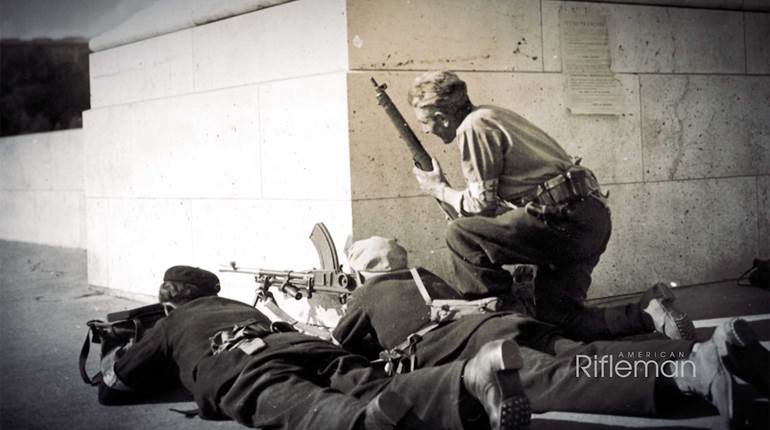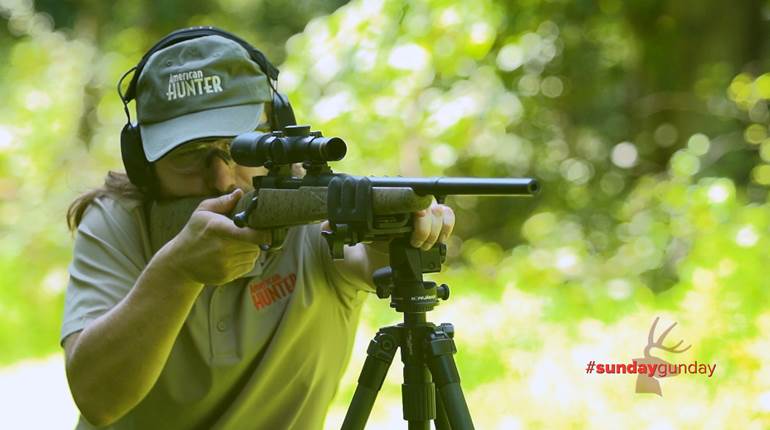
Gallery

Walther PK380
This Walther bears little resemblance to the legendary PP and PPK pistols. It is also well away from the size and weight ranges seen in the other eight guns. It differs in that it is the only pistol under consideration that has a form of DA/SA lockwork. This made the shooting exercises a good bit easier than with the other guns, although there were still a few malfunctions. We used the single-action aspect of the trigger system. The generous butt section and large adjustable sights made it even easier. This design actually began with the company’s inexpensive rimfire pistol, which has the same receiver shell. They put a different slide on top and added proper sights to produce a nice, medium-size .380 pistol. With modernistic styling, the PK380 is rakish-looking, and that alone will sell some guns. Don’t be confused by the Walther-like lever on the rear of the slide. It is nothing more than a safety block that pivots into the path of the hammer, preventing a strike on the firing pin. It is not the decocker mechanism we are used to seeing on Walthers. $425

Taurus 738 TCP
TCP is an abbreviation for “Taurus Compact Pistol,” and the actual gun is a brand-new model in the Taurus catalog—just in time for the “Great .380 Wars.” A molded polymer lower topped with a steel slide combine with a typical recoil-operated system and DAO trigger to produce a little pistol in .380 caliber. The Brazilian designers gave this gun a racy and futuristic look. As it is with several other guns in our series, the TCP has sights integral to the slide that are black and quite small. Such a light gun produces sharp recoil, particularly with the speedy Speer Gold Dot ammunition, so its accuracy was only adequate. A brand-new pistol when we first fired it, the TCP stuttered only twice in the course of a hundred rounds or so. Modestly priced, the Taurus would seem to be a decent choice for the CCW gunner on a budget. Also, the TCP comes with a nicely constructed nylon case that clips to your belt and looks like it holds some electronic gizmo—concealed in plain sight, as it were.$336

SIG Sauer P238
It is kind of surprising that SIG Sauer’s little .380 took the form that it did. For a company that made its bones on advanced DA/SA and DAO pistols, we now have a little gun that is an old-fashioned single-action. In fact, in both appearance and handling, this is a baby M1911. It uses a version of the same tilting barrel recoil operation, the same push-down-to-fire safety and general physical layout. That includes decent-size sights dovetailed into the slide, a magazine catch aft of the trigger guard on the left side and a single-action trigger that works only to release a cocked hammer. As much as the P238 system is similar to the M1911, it is in one way superior. The safety is arranged in such a way that the slide will move with the safety up and on. This means that you can engage the safety for all manipulations of the pistol—loading, clearing jams, etc. Since the safety is important to the function of the pistol, I would choose to carry it “cocked and locked” in some form of holster. The trigger system and readily visible sights made this one easy to shoot. It too exhibited malfunctions, however, with the most common being failures to chamber. $543

Rohrbaugh R380
Inventor and maker of the pistol that bears his name, Karl Rohrbaugh offers exactly the same gun as this one, except that it is in 9 mm. By any measuring stick, the 9 mm is a far better service round than the .380, so I was curious as to why he built the pistol. The answer is because a corps of loyal and vocal fans wanted it for recoil-sensitive shooters in their families. He made the necessary changes to his 9 mm pistol and the resulting .380s are selling briskly. Small wonder, this is an exceedingly well-designed and well-made handgun. Using aluminum receivers topped by steel slides and barrels, R380s feature a recoil-operated system. They have a hammer-fired, DAO lockwork, as well as an unusual heel-mounted magazine catch. Rohrbaugh’s 9 mm pistols are offered with either small sights integral with the slide or no sights at all. The sights are too small to see for any precise shooting, making our accuracy protocol problematic. Gunsite Rangemaster Chris Weare and I did not encounter trigger control issues because the out-of-the-box trigger is very good to excellent. The Rohrbaugh did not malfunction. $1,150

Ruger LCP
A good bit of the interest in small .380s stems from the introduction of this pistol at the 2008 SHOT Show. Several of our nine-gun assortment pre-date the little Ruger, but it is the one that ignited such intense popularity in tiny .380s. It’s easy to see why; the Ruger is an appealing little gun. With a glass-filled nylon lower topped with a steel barrel and slide, the LCP is a recoil-operated gun with DAO lockwork and a speed hammer. The gun is not only small and light, but also relatively thin—just about eight-tenths of an inch. Recoil is snappy and almost painful. In anything but bright daylight, the tiny sights preclude a proper sight picture. Although the Ruger is an uncommonly handsome little rascal, it has a number of edges and corners that you just can’t design out of the gun. We had problems getting through the shooting evaluation. That included a number of feedway malfunctions, which were puzzling. It was the same pistol I had written up shortly after it was introduced. There were no problems then, but a new array of different loads resulted in some jams. I must conclude that the LCP is a bit ammunition-sensitive and you have to pick your loads carefully to keep it running. $364

North American Arms Guardian
The Guardian comes from a maker of small revolvers in .22 LR and .22 Mag. From the outset, I was impressed with the obvious care taken in the fit and finish of this little blowback semi-automatic. It is carefully machined and polished; even the grip panels are precisely molded with a pebble grain surface, and markings on the slide are crisp and sharp. All in all it is a nice-looking, handsomely styled pocket pistol. At 18.72 ounces, it is rather heavy, but the size is comparable to the other guns in this review. The NAA Guardian is all-steel, which explains the weight. There is further need to have a heavy slide on a blowback pistol, particularly when it is to be fired with today’s rather zippy .380 loads. In shooting the Guardian, I found there was not a lot of space for my sausage-like trigger finger in the guard. It also had a rather heavy trigger pull and a long reset. Its small, shiny sights were hard to see. Several malfunctions suggest that the Guardian is another pistol that needs extensive breaking-in. $449

Magnum Research Micro Desert Eagle
The Micro is a new model that stands in sharp contrast to the rest of the company’s assortment of big, powerful Desert Eagle semi-automatic pistols and BFR revolvers. But, even though the Micro Desert Eagle is small, it is made almost completely of steel, so it is comparatively heavy. Another DAO, the gun retains the blowback system used on so many earlier .380s. None of our sample .380s afford the shooter a hand-filling grip, but the Micro seems especially hard to get a shooting grip. Modernistic in its styling, the six-plus-one pistol has square notch rear and post front sights of diminutive proportions. As the gun wears a high polish finish in a bright silver color, it is tough to obtain a good sight picture in daylight. Further, the pistol has a very heavy trigger pull and a number of sharp edges. Add a rather sharp recoil impulse (in part because of the blowback operation) and you have a gun that is challenging to shoot. In the shooting session, I encountered malfunctions in both feeding and chambering. $535

Kel-Tec P3AT
The single most important criteria in selecting a gun for habitual carry is weight—as long as the gun in question is enough gun for the job. If you are considering a .380, you cannot find one that is lighter than the 8.3-ounce P3AT. While Kel-Tec has branched off into some interesting long guns in recent years, the firm’s bread and butter has been small semi-automatic pistols at low prices. It actually makes a smaller and lighter version of this gun in .32 ACP. Using a light, slim polymer receiver that houses the lockwork and a single-column magazine of six rounds, the P3AT is indeed a light, small package. It’s a hammer-fired DAO, in which the mass of the hammer is concentrated around the point of pivot. The gun is not easy to shoot, in that the sights are small and hard to see, and it has too many sharp edges and corners. Further, the P3AT is prone to malfunction with several kinds of ammunition. I suspect that the Kel-Tec needs a great deal of breaking-in before it goes into service. $318

Kahr P380
Kahr’s little .380 is the latest and smallest pistol in its now-extensive line. Kahr's first larger-caliber pistols had steel receivers, but the demands of the CCW crowd drove it to develop a polymer receiver applicable to all calibers. It is the polymer receiver that is used for the .380. Like other Kahrs, the gun is a recoil-operated, striker-fired double-action-only (DAO) design with a relatively smooth, if rather long, trigger pull. The Kahr has many of the good features of full-size semi-automatics, not the least of which is sights dovetailed into the slide. A flat pistol (because of a clever offset feed ramp), the Kahr conceals easily and has no sharp edges or corners to impede the draw stroke. In Kahr’s brief history armed professionals have accepted and have regularly carried the company’s guns. At the range, I found the pistol to be of sound ergonomic design and easy to manage. There were several malfunctions—usually failures to chamber. I have to note that Kahr states in its literature that its pistols need to be fired at least 200 rounds before going into active service as a defensive firearm. $758




































